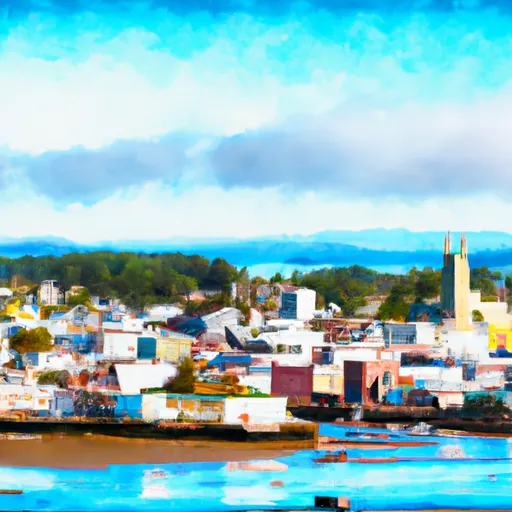-
 Snoflo Premium
Snoflo Premium
Get unlimited access to all our content
With no Ad interruptions! - Start Your Free Trial Login with existing account
Westport
Eden Index
Climate
6.2
•
Recreation
4.0
•
Community
1.5
•
Safeguard
4.2/10

Westport, Washington is a picturesque coastal town located in Grays Harbor County. Known for its stunning natural beauty, Westport offers a mild and temperate climate with cool summers and mild winters. The area experiences high levels of rainfall throughout the year, making it lush and green.
As for hydrology constituents, Westport is situated at the mouth of the Chehalis River, contributing to its vibrant ecosystem. The river brings nutrient-rich water that supports various aquatic life, including salmon and steelhead. The coastal location also offers opportunities for beachcombing, crabbing, and clam digging.
Outdoor recreation enthusiasts will find plenty to do in Westport. The town boasts beautiful beaches, perfect for swimming, sunbathing, and building sandcastles. Surfing is incredibly popular here, attracting surfers from all around due to its consistent waves. Anglers can enjoy excellent fishing opportunities both in the river and the ocean, with salmon, halibut, and lingcod being common catches. Additionally, Westport is home to several state parks and trails, providing ample opportunities for hiking, bird-watching, and wildlife spotting.
In summary, Westport, Washington offers a mild climate, a thriving hydrology system, and a variety of outdoor recreation opportunities. From its beautiful beaches to the abundant fishing and surfing spots, Westport is a nature lover's paradise.
What is the Eden Index?
The Snoflo Eden Index serves as a comprehensive rating system for regions, evaluating their desirability through a holistic assessment of climate health, outdoor recreation opportunities, and natural disaster risk, acknowledging the profound impact of these factors on livability and well-being.
Climate Health Indicator (CHI): 6.2
Westport receives approximately
1900mm of rain per year,
with humidity levels near 86%
and air temperatures averaging around
10°C.
Westport has a plant hardyness factor of
9, meaning
plants and agriculture in this region tend to thrive here all year round.
By considering the ideal temperature range, reliable water supplies, clean air, and stable seasonal rain or snowpacks, the Climate Health Indicator (CHI) underscores the significance of a healthy climate as the foundation for quality living.
A healthy climate is paramount for ensuring a high quality of life and livability in a region, fostering both physical well-being and environmental harmony. This can be characterized by ideal temperatures, reliable access to water supplies, clean air, and consistent seasonal rain or snowpacks.
Weather Forecast
Streamflow Conditions
Washington Coastal
Area Rivers
Washington Coastal
Snowpack Depths
Washington Coastal
Reservoir Storage Capacity
Washington Coastal
Groundwater Levels
Recreational Opportunity Index (ROI): 4.0
The Recreational Opportunity Index (ROI) recognizes the value of outdoor recreational options, such as parks, hiking trails, camping sites, and fishing spots, while acknowledging that climate plays a pivotal role in ensuring the comfort and consistency of these experiences.
Access to outdoor recreational opportunities, encompassing activities such as parks, hiking, camping, and fishing, is crucial for overall well-being, and the climate plays a pivotal role in enabling and enhancing these experiences, ensuring that individuals can engage in nature-based activities comfortably and consistently.
Camping Areas
| Campground | Campsites | Reservations | Toilets | Showers | Elevation |
|---|---|---|---|---|---|
| Twin Harbors State Park | 300 | 19 ft | |||
| Pacific Beach State Park | 86 | 23 ft | |||
| Promised Land Park - Rayonier Timber Co | None | 251 ft | |||
| Ocean City State Park | 175 | 17 ft | |||
| Grayland Beach State Park | 58 | 22 ft | |||
| Pacific Beach Military | None | 75 ft | |||
| Westport Recreation Park - Military | None | 16 ft |
Catastrophe Safeguard Index (CSI):
The Catastrophe Safeguard Index (CSI) recognizes that natural disaster risk, encompassing floods, fires, hurricanes, and tornadoes, can drastically affect safety and the overall appeal of an area.
The level of natural disaster risk in a region significantly affects safety and the overall livability, with climate change amplifying these risks by potentially increasing the frequency and intensity of events like floods, fires, hurricanes, and tornadoes, thereby posing substantial challenges to community resilience and well-being.
Community Resilience Indicator (CRI): 1.5
The Community Resilience Indicator (CRI) recognizes that education, healthcare, and socioeconomics are crucial to the well-being of a region. The CRI acknowledges the profound impact of these elements on residents' overall quality of life. By evaluating educational resources, healthcare accessibility, and economic inclusivity, the index captures the essential aspects that contribute to a thriving community, fostering resident satisfaction, equity, and social cohesion.

